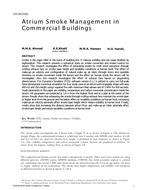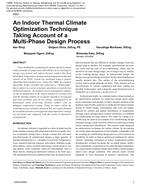Ventilation in multi-family buildings throughout North America is commonly provided using a pressurized corridor system whereby make-up airpressurizes the corridor and passes in to the suites. The system relies on the directed airflow from the corridors to the suites to provide proper ventilation tomaintain indoor air quality requirements. Previous studies have indicated that a majority of the designed ventilation air is not being delivered to the suites.This leads to potential for indoor air quality issues and occupant complaints of discomfort. Temperature, relative humidity, and carbon dioxide (CO2)sensors were installed in suites of a 13 storey multi-family building in Vancouver, BC to monitor indoor air quality between August 2012 and August2015. Measurements were recorded at 1-hour intervals to allow for a comparison of indoor conditions during different seasons and between suites withinthe building. Significant differences were found when comparing the indoor air quality between suites located on the upper floors (10-12) and the lowerfloors (2-4). The CO2 concentrations in the upper suites exceeded 1100ppm less than 5% of the time compared to 42-87% for lower suites. Thedifference in CO2 concentration can be attributed to higher ventilation rates provided by the mechanical system as measured using perfluorocarbon tracertesting. CO2 concentrations showed a seasonal profile with the highest concentrations seen during January and low concentrations in July. The range ofaverage monthly CO2 concentration was greater for suites on the lower floors (800ppm to 1800ppm) compared to the upper floors (550ppm to 800ppm).The lower summer CO2 concentrations in all suites are attributed to occupant window opening behaviour providing improved ventilation. Temperatureand relative humidity measurements throughout the study were typically within the design parameters (21 to 25° C and 30% to 60%, respectively) for allsuites. A trend for higher indoor dewpoint temperature was found in suites on lower floors leading to greater potential for condensation and mold growth.The elevated CO2 concentrations found in this study are greater than those proposed from ASHRAE ventilation guidelines and may have detrimentaleffects on building occupants. The results at this case study building are likely representative of conditions of many low to high-rise multi-family buildingsventilated with pressurized corridor systems. Alternative ventilation methods are recommended to improve indoor air quality and reduce occupantexposure.
Citation: ASHRAE and AIVC IAQ 2016 Conf
Product Details
- Published:
- 2016
- Number of Pages:
- 8
- Units of Measure:
- Dual
- File Size:
- 1 file , 770 KB
- Product Code(s):
- D-2016IAQ-14


